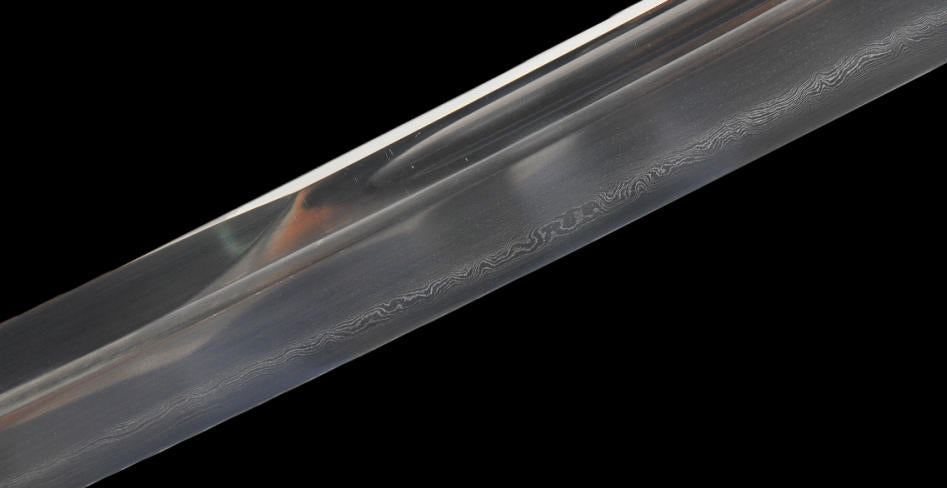เหตุใดผู้ที่ชื่นชอบดาบและนักศิลปะการต่อสู้จึงชอบดาบคาทาน่าเหล็กพับมากกว่า?

คาตานะเหล็กพับแบบไหนดีกว่าสำหรับสะสมหรือต่อสู้? นักสะสมและผู้ที่ชื่นชอบศิลปะการต่อสู้คิดอย่างไร?
ดาบคาตา นะเหล็กพับเป็นที่ต้องการอย่างมากในหมู่ผู้ที่ชื่นชอบดาบ ศิลปะการต่อสู้ และแฟนอ นิเมะ ด้วย เทคนิคการตีดาบที่เป็นเอกลักษณ์ ลวดลายเกรนเหล็กอันงดงาม (ฮาดะ) และประสิทธิภาพการใช้งานที่ยอดเยี่ยม บทความนี้จะสำรวจ ประวัติศาสตร์ เทคนิคการพับ คุณสมบัติของวัสดุ มูลค่าการใช้งานและมูลค่าสะสม รวมถึงความสำคัญทางวัฒนธรรมสมัยใหม่ ของดาบคาตานะเหล็กพับ พร้อมทั้งผสานรวมคีย์เวิร์ด SEO เช่น 'คอลเลกชันดาบคาตานะเหล็กพับ' 'การวิเคราะห์ฝีมือดาบคาตานะเหล็กพับ' และ 'เทคนิคการตีดาบญี่ปุ่น'
เหล็กพับคืออะไร?
ในภาษาจีน เหล็กพับมักเรียกกันว่า '折叠钢' หรือ '叠钢'
หมายถึงกระบวนการผลิตเหล็กกล้าคาร์บอนสูง ซึ่งเกี่ยวข้องกับ การตีเหล็ก การพับ และการตีเหล็กซ้ำๆ ซึ่งเดิมทีพัฒนาขึ้นสำหรับการผลิต ดาบคาตานะของญี่ปุ่น กระบวนการพับเหล็กนี้ทำให้เหล็กกล้ามีข้อดีหลายประการ ได้แก่:
-
การกำจัดสิ่งเจือปน – ผลิตโครงสร้างเหล็กที่บริสุทธิ์ยิ่งขึ้น
-
ความเหนียวที่เพิ่มขึ้น – สร้างใบมีดที่แข็งแกร่งขึ้นเพื่อต้านทานการแตกหัก
-
ลายเม็ดเหล็กอันเป็นเอกลักษณ์ (ฮาดะ) – ดาบแต่ละเล่มมีความพิเศษเฉพาะตัว มอบทั้งคุณค่าด้านสุนทรียศาสตร์และมูลค่าสะสม
ดังนั้น เหล็กพับจึงไม่เพียงแต่เป็น วิธีการบำบัดวัสดุ เท่านั้น แต่ยังเป็นสัญลักษณ์สำคัญของวัฒนธรรมดาบญี่ปุ่นและสุนทรียศาสตร์ของงานฝีมืออีกด้วย
ต้นกำเนิดทางประวัติศาสตร์: เรื่องราวในตำนานของเหล็กพับ
เหล็กพับ (Folded Steel) เกิดจากความชาญฉลาดของช่างตีดาบชาวญี่ปุ่นโบราณที่ต้องเผชิญกับคุณภาพเหล็กที่ไม่สม่ำเสมอ สิ่งเจือปน และความเหนียวที่ไม่เพียงพอ พวกเขาพัฒนาเทคนิคการตีเหล็กอันเป็นเอกลักษณ์ ด้วยการพับและตีเหล็กซ้ำๆ ค่อยๆ กำจัดสิ่งเจือปนออกและสร้างลวดลายชั้นๆ ที่สวยงาม (Hada) ภายในใบมีด กระบวนการนี้เปลี่ยนเหล็กธรรมดาให้กลายเป็นใบมีดคุณภาพระดับศิลปะที่มี ความคม เหนียว และความทนทาน
ในยุคเซ็นโกกุ ดาบคาตานะเหล็กพับไม่เพียงแต่เป็นสุดยอดแห่งฝีมือการตีดาบเท่านั้น แต่ยังเป็น สัญลักษณ์แห่งสถานะและอัตลักษณ์ของซามูไร อีกด้วย ดาบคาตานะเหล็กพับที่ประดิษฐ์อย่างประณีตถูกนำมาใช้ในการต่อสู้ ขณะเดียวกันก็เป็นตัวแทนของความภักดี เกียรติยศ และความกล้าหาญของซามูไร เหล็กแต่ละชั้นสะท้อนถึงความทุ่มเทและทักษะของช่างตีดาบ สะท้อนถึงจิตวิญญาณอันบริสุทธิ์และมั่นคงของซามูไร
ในยุคปัจจุบัน ดาบเหล็กพับยังคงสืบทอดประเพณีอันเก่าแก่นี้ไว้ ควบคู่ไปกับการผสมผสานวัสดุและเทคโนโลยีสมัยใหม่ ส่งผลให้ใบดาบมีความมั่นคงและเหมาะสมกับการใช้งานจริงมากขึ้น ไม่ว่าจะใช้เพื่อการต่อสู้หรือเป็นสมบัติล้ำค่าสำหรับนักสะสม ดาบคาตานะเหล็กพับสมัยใหม่ก็ยังคงสืบทอดความรุ่งเรืองทางประวัติศาสตร์ไว้ได้อย่างลงตัว ผสมผสาน วัฒนธรรมดาบเก่าแก่หลายศตวรรษเข้ากับงานฝีมือร่วมสมัย ได้อย่างลงตัว
ยิ่งไปกว่านั้น ลวดลายเหล็กพับแบบหลายชั้นอันเป็นเอกลักษณ์เฉพาะตัวไม่เพียงแต่มอบความสวยงาม แต่ยังรับประกันว่าใบมีดแต่ละใบจะมีเอกลักษณ์เฉพาะตัวอย่างแท้จริง การพับแต่ละครั้งมอบพื้นผิวและเอกลักษณ์เฉพาะตัว สะท้อนปรัชญาของช่างตีดาบชาวญี่ปุ่นที่ว่า ' ดาบคือจิตวิญญาณ เหล็กกล้าคือหัวใจ '
คุณสมบัติของวัสดุ: ความสมดุลของความคมและความเหนียว
โดยทั่วไปแล้วดาบคาทานะเหล็กพับจะทำมาจากเหล็กกล้าคาร์บอนสูง เช่น T10, 1095 หรือ 9260 ผสมผสานกับ การพับซ้ำหลายครั้งและการอบชุบด้วยความร้อนที่แม่นยำ ผสมผสานเทคนิคดั้งเดิมเข้ากับเทคโนโลยีสมัยใหม่ได้อย่างลงตัว เพื่อให้มีความคมและเหนียวสำหรับการใช้งานจริงและการสะสม
-
ความแข็งและความคมชัดสูง
ใบมีดถูกพับและชุบแข็งหลายครั้ง ทำให้เกิดโครงสร้างเหล็กที่หนาแน่น ส่วนผสมของคาร์บอนสูงผสานกับการพับ ช่วยให้มั่นใจได้ถึงความคมที่ยาวนาน เหมาะสำหรับการฝึกซ้อมการหั่น การจำลองการตัด และการฟันที่แม่นยำ คมมีดยังคงความคมสม่ำเสมอ ให้การตัดที่ราบรื่น ควบคุมได้ และการควบคุมที่ยอดเยี่ยม -
ความเหนียวและทนต่อแรงกระแทก
โครงสร้างเหล็กพับแบบหลายชั้นช่วยเพิ่มทั้งความเหนียวและทนต่อแรงกระแทก เมื่อปะทะหรือกระแทกอย่างแรง ใบมีดจะกระจายแรงอย่างสม่ำเสมอ ลดความเสี่ยงของการบิ่นหรือแตกหัก มอบความปลอดภัยและความน่าเชื่อถือในการฝึกซ้อมหรือการต่อสู้ -
เมล็ดเหล็กที่เป็นเอกลักษณ์ (ฮาดะ)
ดาบคาตานะเหล็กพับแต่ละเล่มมีลวดลายฮาดะอันเป็นเอกลักษณ์เฉพาะตัว ซึ่งกำหนดโดยจำนวนการพับ เทคนิคการตี และคุณสมบัติของเหล็ก ลวดลายธรรมชาติเหล่านี้ไม่เพียงแต่มีคุณค่าทางสุนทรียะสูงเท่านั้น แต่ยังแสดงให้เห็นถึงทักษะการตีดาบของช่างตีดาบ ผสมผสานการใช้งานจริงเข้ากับความงามอันน่าสะสม
นอกจากนี้ โครงสร้างแบบหลายชั้นของใบมีดยังมอบความยืดหยุ่นที่ละเอียดอ่อน ช่วยให้การฟันดาบราบรื่นยิ่งขึ้นและให้ความรู้สึกสบายมือ สะท้อนปรัชญา "คมกริบแต่ยืดหยุ่น" ของดาบแบบดั้งเดิมได้อย่างสมบูรณ์แบบ ไม่ว่าจะใช้ในการฝึกศิลปะการต่อสู้ การสาธิตการฟันดาบ หรือเป็นของสะสมระดับพรีเมียม ดาบคาตานะเหล็กพับก็แสดงให้เห็นถึงฝีมือและการใช้งานอันเหนือชั้น
งานฝีมือ: ความเชี่ยวชาญที่หล่อหลอมจากการโจมตีนับพันครั้ง
การประดิษฐ์ดาบคาทานะเหล็กพับนั้นต้องพิถีพิถันมาก โดยใบดาบแต่ละใบต้องผ่านขั้นตอนต่างๆ มากมาย สะท้อนให้เห็นถึงปรัชญาของดาบญี่ปุ่นที่ว่า ' ดาบคือจิตวิญญาณ งานฝีมือคือหัวใจ '
-
การตีขึ้นรูปด้วยมือ
กระบวนการนี้เริ่มต้นด้วยเหล็กกล้าคาร์บอนสูงที่คัดสรรมาอย่างพิถีพิถัน นำไปให้ความร้อนจนถึงอุณหภูมิการตีขึ้นรูป และผ่าน การตีและพับซ้ำๆ การพับแต่ละครั้งจะช่วยขจัดสิ่งสกปรกและเพิ่มความหนาแน่นของเหล็ก ก่อให้เกิดลวดลายชั้นๆ ที่เป็นเอกลักษณ์เฉพาะตัว (ฮาดะ) ของใบมีด หลังจากพับหลายสิบครั้ง ใบมีดจะแข็งแกร่งและคมกริบเป็นพิเศษ การตีด้วยค้อนแต่ละครั้งแสดงให้เห็นถึงสมาธิและความอดทนของช่างตีดาบ สร้างสรรค์คาตานะอันเป็นเอกลักษณ์เฉพาะตัว -
การชุบดินเหนียว (Clay Quenching)
ใบมีดจะถูกเคลือบด้วยดินเหนียวบางๆ ก่อนการชุบแข็งอย่างพิถีพิถัน วิธีนี้จะทำให้คมมีดแข็งแรงขึ้น แต่ยังคงความยืดหยุ่นของสันดาบไว้ได้อย่างดี ช่วยเพิ่มความคมชัดและการดูดซับแรงกระแทกได้อย่างมาก นอกจากนี้ กระบวนการนี้ยังก่อให้เกิดลวดลายคลื่น (Hamon) ซึ่งเป็นหนึ่งในองค์ประกอบทางศิลปะที่โดดเด่นที่สุดของดาบคาตานะเหล็กพับ โดย Hamon แต่ละชิ้นจะมีเอกลักษณ์เฉพาะตัว สะท้อนถึงทักษะและสุนทรียศาสตร์ของช่างตีดาบ -
การขัดเงาและการตกแต่ง
หลังจากการตีขึ้นรูปและชุบแข็ง ใบมีดจะได้รับการขัดเงาอย่างพิถีพิถัน ขอบ สัน และพื้นผิวใบมีดได้รับการขัดเงาอย่างละเอียดเพื่อเผยให้เห็นลายเหล็กและเพิ่มความคม การขัดเงาช่วยเน้นความงามของใบมีด พร้อมมอบความสมดุลและความสบายในการใช้งาน
การผสมผสานระหว่าง งานฝีมือแบบดั้งเดิมและความแม่นยำสมัยใหม่ นี้ทำให้คาตานะเหล็กพับเป็นเลิศทั้งในด้าน ประสิทธิภาพการใช้งานจริง และ มูลค่าสะสม ใบมีดแต่ละใบเป็นเครื่องพิสูจน์ถึงฝีมือและความอดทนของช่างตีดาบ ไม่ว่าจะเป็นศิลปะการต่อสู้ การสาธิตการฟันดาบ หรือการสะสมอันทรงคุณค่า
การใช้งานจริงและมูลค่าสะสม
ดาบคาตานะเหล็กพับไม่เพียงแต่เป็นสุดยอดแห่งศิลปะการตีดาบญี่ปุ่นแบบดั้งเดิมเท่านั้น แต่ยังเป็นตัวเลือกที่เหมาะสำหรับผู้ที่ชื่นชอบดาบสมัยใหม่และผู้ฝึกศิลปะการต่อสู้อีกด้วย วัสดุที่เป็นเอกลักษณ์และฝีมืออันประณีตทำให้ดาบคาตานะมีคุณค่าอย่างยิ่งใน การต่อสู้ การสะสม และบริบททางวัฒนธรรม
-
การฝึกศิลปะการต่อสู้
คาตานะเหล็กพับมีความทนทานสูงและคมกริบยาวนาน เหมาะสำหรับศิลปะการต่อสู้อย่างอิไอโด ทาเมชิกิริ (การตัดทดสอบ) และการสาธิตเคนโด้ เหล็กพับคาร์บอนสูงที่ผ่านการตีและชุบแข็งซ้ำแล้วซ้ำเล่า สามารถทนต่อแรงกระแทกสูงได้หลายครั้งโดยไม่บิ่นหรือแตกหัก มอบประสบการณ์การฝึกฝนที่ปลอดภัยและมั่นคง สมดุลอันยอดเยี่ยมของใบมีด ด้ามจับที่กระชับมือ และการเคลื่อนไหวการตัดที่นุ่มนวล ช่วยให้ผู้ฝึกพัฒนาเทคนิคและยกระดับความสวยงามของท่วงท่า -
การรวบรวมและการจัดแสดง
คาตานะเหล็กพับแต่ละเล่มมีลวดลายเฉพาะตัว (ฮาดะ) และลวดลายฮามอน (ฮามอน) ทำให้ดาบแต่ละเล่มเป็นงานศิลปะชิ้นเอกที่ไม่เหมือนใคร ผสมผสานกับฝักดาบที่ประณีตบรรจง ปลอกหุ้มด้าม และอุปกรณ์ตกแต่งแบบดั้งเดิม (โคชิราเอะ) คาตานะเหล่านี้แสดงให้เห็นถึงความเชี่ยวชาญของช่างตีดาบและสะท้อนมรดกทางวัฒนธรรมอันล้ำค่าของการทำดาบญี่ปุ่น นักสะสมสามารถสัมผัสได้ถึงเนื้อสัมผัส ความเงางาม และการออกแบบโดยรวมของใบดาบ ทำให้เป็นจุดเด่นในบ้าน สำนักงาน หรือของสะสมส่วนตัว -
อนิเมะและความสำคัญทางวัฒนธรรม
ด้วยสุนทรียศาสตร์อันโดดเด่นและความหมายทางประวัติศาสตร์และวัฒนธรรม ดาบคาตานะเหล็กพับจึงมักเป็นแรงบันดาลใจให้กับดาบในภาพยนตร์ อนิเมะ และเกม ตัวอย่างที่โดดเด่น ได้แก่ ผลงานอย่าง รูโรนิ เคนชิน และ ดาบพิฆาตอสูร (Kimetsu no Yaiba) ที่ตัวละครเอกถือดาบที่จำลองแบบมาจากดาบคาตานะเหล็กพับ ลวดลายเลเยอร์และลายเส้นคมกริบทำให้ดาบในจินตนาการเหล่านี้มีเสน่ห์ดึงดูดสายตา ทำให้เป็นที่นิยมในหมู่ ผู้ที่ชื่นชอบคอสเพลย์ นักสะสมทางวัฒนธรรม และแฟนอนิเมะ ไม่ว่าจะใช้เป็นอุปกรณ์ประกอบฉากในภาพยนตร์ ของสะสมตามบทบาท หรือของจัดแสดงทางวัฒนธรรม ดาบคาตานะเหล็กพับก็มีความสำคัญทางประวัติศาสตร์ ศิลปะ และวัฒนธรรมป๊อป
โดยสรุปแล้วดาบคาทานะเหล็กพับผสมผสาน ประสิทธิภาพการต่อสู้ที่ใช้งานได้จริง มูลค่าสะสม และความหมายทางวัฒนธรรม ทำให้ไม่เพียงแต่เป็นเครื่องมือศิลปะการต่อสู้เท่านั้น แต่ยังเป็นสัญลักษณ์ของศิลปะและมรดกอีกด้วย ซึ่งเป็นที่ต้องการอย่างมากจากผู้ที่ชื่นชอบดาบทุกคน
การออกแบบด้านสุนทรียศาสตร์: การผสมผสานระหว่างความงามและฟังก์ชัน
ดาบคาตานะเหล็กพับได้รับการออกแบบอย่างพิถีพิถันเพื่อความสมดุลระหว่าง การใช้งานและความสวยงาม ทุกรายละเอียดได้รับการรังสรรค์อย่างพิถีพิถันเพื่อให้มั่นใจถึงประสิทธิภาพสูงสุด พร้อมเสริมความงามทางสายตา
-
ด้ามจับ (Tsuka)
ด้ามจับหุ้มด้วยหนังกระเบนแท้ (Samegawa) และมัดแน่นด้วยเชือกไหม (Ito) ผิวสัมผัสตามธรรมชาติของหนังกระเบนผสานกับเชือกไขว้ ช่วยให้ จับกระชับมือ ป้องกันการลื่นไหลได้อย่างดีเยี่ยม มั่นคงแม้ใช้งานเป็นเวลานาน ด้ามจับยังให้ความรู้สึกสบายตามหลักสรีรศาสตร์ ช่วยให้ควบคุมได้อย่างแม่นยำและลื่นไหล ดาบคาตานะสั่งทำพิเศษระดับไฮเอนด์สามารถปรับขนาดมือและด้ามจับได้ตามต้องการ มอบประสบการณ์การใช้งานที่เป็นส่วนตัวอย่างแท้จริง -
ฝักดาบ (ซายะ)
ฝักดาบมักทำจากไม้เคลือบแล็กเกอร์ มีให้เลือกทั้งลวดลายที่ประณีตหรือลายไม้ธรรมชาติ ดาบระดับพรีเมียมบางเล่มมีตราประจำตระกูล (Mon) ที่กำหนดเอง ซึ่งสะท้อนถึงมรดกส่วนบุคคลหรือมรดกทางครอบครัว ฝักดาบที่เรียบและทนทานช่วยให้ชักและเก็บฝักดาบได้อย่างรวดเร็ว พร้อมทั้งปกป้องใบดาบจากการเกิดออกซิเดชันและการสึกหรอ ช่วยเพิ่มสัมผัสแห่งความงดงามและประณีต -
ฟิตติ้ง (สึบะ, เมนูกิ, คาชิระ)
อุปกรณ์ดาบมีไว้เพื่อการตกแต่งและการใช้งาน ช่วยปรับสมดุลใบดาบและเพิ่มประสิทธิภาพในการจับ ด้ามดาบ (ซึบะ) สามารถผลิตได้ทั้งแบบดั้งเดิมและแบบโมเดิร์น ส่วนเมนุกิช่วยเพิ่มแรงเสียดทานภายในด้ามดาบ และคาชิระช่วยยึดจับให้มั่นคง ฝีมือการแกะสลักและฝังที่ประณีตบรรจงทำให้คาตานะทั้งใช้งานได้จริงและสวยงาม ยกระดับคาตานะให้กลายเป็นงานศิลปะ -
ลวดลายฮามอนและฮาดะ
ลายอารมณ์ (ฮามอน) เกิดขึ้นตามธรรมชาติหลังจากการชุบแข็งด้วยดินเหนียว โดยคลื่นแต่ละลูกจะสะท้อนให้เห็นฝีมือของช่างตีดาบ ลายเหล็กพับ (ฮาดะ) เกิดขึ้นจากการตีซ้ำๆ ก่อให้เกิดพื้นผิวที่เป็นธรรมชาติและการสะท้อนแสงแบบไดนามิก ลวดลายเหล่านี้ช่วยเสริมทั้งความงามและความสมบูรณ์ของโครงสร้างใบมีด สะท้อนถึงความสำคัญทางประวัติศาสตร์และศิลปะ
การผสมผสานระหว่างประโยชน์ใช้สอยและศิลปะ นี้ทำให้คาตานะเหล็กพับไม่เพียงแต่เป็นอาวุธที่น่าเกรงขามเท่านั้น แต่ยังเป็นงานศิลปะที่น่าสะสมอีกด้วย ไม่ว่าจะใช้เพื่อการฝึกศิลปะการต่อสู้ การสาธิตอิไอโด หรือการจัดแสดง คาตานะเหล่านี้ล้วนแสดงให้เห็นถึงฝีมือดั้งเดิมและสุนทรียศาสตร์อันเป็นเอกลักษณ์ของการทำดาบญี่ปุ่น
การแนะนำผลิตภัณฑ์: ดาบคาตานะซามูไรญี่ปุ่น Gyaku-Kobuse ตีขึ้นด้วยมือ เหล็กกล้าคาร์บอน 1095 + เหล็กกล้าพับชุบดินเหนียว
ดาบคาตานะ Gyaku-Kobuse ตีขึ้นมือของญี่ปุ่น นี้ ผสมผสาน เหล็กกล้าคาร์บอนสูง 1095 เข้ากับเหล็กกล้าพับ และ ผ่านการชุบแข็งด้วยดินเหนียว (Clay Tempered) เพื่อให้ได้ความสมดุลระหว่างความคม ความเหนียว และความทนทานอย่างสมบูรณ์แบบ โครงสร้างคอมโพสิตแบบย้อนกลับของ Gyaku-Kobuse ช่วยให้ใบมีดมีความแข็งแต่ยังคงความยืดหยุ่นขณะตัด ผสมผสานสุนทรียศาสตร์แบบดั้งเดิมเข้ากับประสิทธิภาพการใช้งานจริง
คุณสมบัติผลิตภัณฑ์:
-
แกนเหล็กกล้าคาร์บอนสูง – ช่วยให้คมและมีพลังการตัดที่แข็งแกร่ง เหมาะอย่างยิ่งสำหรับการฝึกซ้อมศิลปะการต่อสู้และการตัดทดสอบ
-
ใบมีดเหล็กพับ – การตีขึ้นรูปหลายชั้นทำให้มีความเหนียวเป็นเลิศ ป้องกันการกระเทาะและแตกหัก และแสดงลายเหล็กธรรมชาติ (ฮาดะ) เพื่อความสวยงาม
-
เทคนิคการชุบแข็งด้วยดินเหนียว – สร้างรูปแบบการชุบแข็งที่เป็นเอกลักษณ์ (Hamon) โดยรักษาความสมดุลระหว่างความแข็งของขอบและความยืดหยุ่นของสันมีด
-
ดีไซน์ดาบคาทานะคลาสสิก – ใบดาบโค้งตามสัดส่วนแบบดั้งเดิม ด้ามจับหุ้มด้วยหนังกระเบนแท้เพื่อการจับที่สบายและมั่นคง ฝักดาบเคลือบแล็กเกอร์เรียบเพิ่มความสง่างาม
-
มูลค่าสะสมและจัดแสดง – ฮาดะ ฮามอน และอุปกรณ์ต่างๆ ของใบมีดเป็นแบบคลาสสิกและประณีต เหมาะสำหรับผู้ที่ชื่นชอบดาบ นักศิลปะการต่อสู้ หรือการจัดแสดงทางวัฒนธรรม
ดาบคาทานะ Gyaku-Kobuse ที่ทำจากเหล็กกล้าคาร์บอน 1095 + เหล็กพับ นี้ไม่เพียงแต่เป็นดาบที่ใช้งานได้จริงเท่านั้น แต่ยังเป็นศูนย์รวมที่สมบูรณ์แบบของวัฒนธรรมซามูไรและฝีมือการตีดาบของญี่ปุ่น เหมาะสำหรับ นักศิลปะการต่อสู้ นักสะสม และแฟน ๆ วัฒนธรรมอะนิเมะ
บทสรุป: ทำไมดาบคาทาน่าเหล็กพับจึงคุ้มค่าแก่การเป็นเจ้าของ
คาตานะเหล็กพับถ่ายทอด ประวัติศาสตร์และจิตวิญญาณของซามูไรญี่ปุ่น ขณะเดียวกันก็ผสานเทคนิคการทำดาบสมัยใหม่ มอบ คุณค่าที่ใช้งานได้จริง น่าสะสม และทางวัฒนธรรม ไม่ว่าจะเป็นผู้ที่ชื่นชอบศิลปะการต่อสู้ นักสะสมดาบ หรือแฟนอนิเมะและภาพยนตร์ คาตานะเหล็กพับคุณภาพสูงจะมอบประสบการณ์อันหลากหลาย ทั้งความงดงามทางสายตา ประสิทธิภาพการใช้งาน และความสำคัญทางวัฒนธรรม









